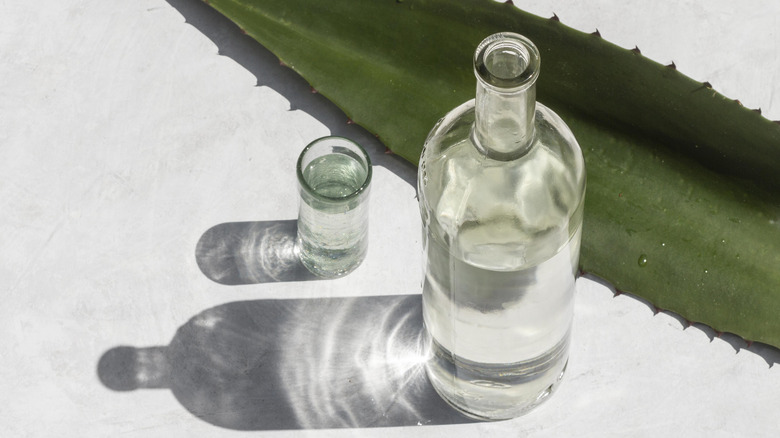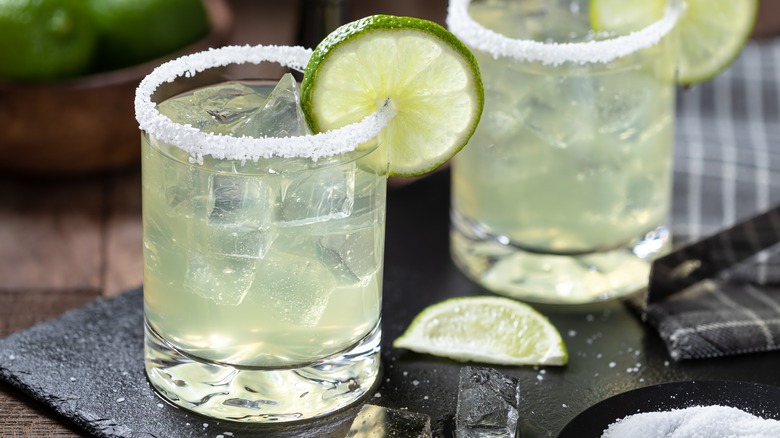Gordon Ramsay's Go-To Margarita Substitutes The Main Ingredient
Since their inception, margaritas have always been a mix of tequila, orange liqueur (usually Triple Sec), and a dash of sweetener like simple syrup. But where's the fun in drinking a single recipe day in and day out? Gordon Ramsay had the right idea when he decided to change it up a little to get a brand-new flavor: Instead of tequila, he swapped it out with mezcal.
You can find the intriguing recipe on his restaurant's website. It calls for 50 milliliters of mezcal, 25 milliliters of lime juice, and 15 milliliters of agave juice. Each of these ingredients may seem unconventional for a margarita, but upon closer examination — and, of course, tasting — all of these substitutions make perfect sense.
Unlike the smoothness of tequila, mezcal imparts a smokier, more complex taste to the drink, thanks to the unique baking step in its production process (which tequila doesn't undergo). This extra element completely transforms the cocktail's flavor profile, resulting in a surprising sip that'll give you pause when you try it for the first time. And if you enjoy your drink strong and bold, who knows, this new take on the classic might just be your new go-to.
The magic of mezcal
For those unfamiliar with Mexican spirits, mezcal refers to any spirit that's distilled from the juice of the agave plant. If you know your tequila, you'll know it's also made from agave juice, technically making it a type of mezcal. However, what sets mezcal and tequila apart is that tequila is made exclusively from the Weber blue agave, grown in only five states in Mexico. In contrast, mezcal encompasses drinks made from all 40 strains of agave found throughout Mexico.
The reason why you'd want to sub it into your margarita is because of its distinct smoky flavor compared to tequila. In the production process, the core of the agave plant (piña) is roasted in conical pits, similar to the peating process in whisky. For tequila, the piña is steamed, which gives a smoother flavor profile.
Additionally, mezcal isn't subject to the same strict regulations as tequila, leading to a wide range of flavor expressions across different brands and bottlings. Experimenting with these flavor notes can be quite enjoyable if you're the one mixing the cocktail. And for the taster, the diverse flavors in mezcal promise a far more unique sip than the standard margarita.
Picking out a good mezcal for your margarita
Even though smokiness is the selling point for mezcal, you'll probably want to pick a bottle that's light on the smoke. If the smoke is too intense, you run a pretty high risk of it overwhelming the flavor of the cocktail. Instead, you'll want to spring for mezcals that are more agave-forward and taste more similar to the traditional tequila that's used in margaritas. Since there are so many mezcal brands out there (397 brands by 2022, according to Statista,) finding the perfect brand and bottle that meets these requirements will require you to do some digging.
Look for brands that use copper stills, as they tend to balance out the smokiness while keeping the agave flavor prominent. Brands like Lágrimas de Dolores or Banhez Mezcal fit this description well. Alternatively, seek out brands that employ traditional distilling methods using clay pots, such as Macurichos.
Mix your chosen mezcal together with agave juice, which will only embolden the flavor of the alcohol compared to something like Triple Sec. Then, with a touch of acidity with lime juice and a good shake with ice (or blended, if you want to make a frozen margarita,) you'll have a tasty drink ready for serving.


